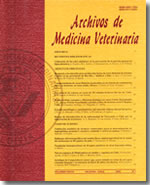Anaplocephala perfoliata in the Northwest of Colombia
Main Article Content
Abstract
Different studies have been developed in relation to the diagnostic and prevalence of Anoplocephala perfoliata, however, in tropical countries such as Colombia there are few descriptions of this in the equine industry. The aim of this study is to describe the presence of this parasite in the Northwest regions of Colombia by using methods of sedimentation/flotation in 135 equids: 105 horses, 2 ass and 28 mules. A total of 31.7% animals resulted positive: 15% in Marmato, 13% in Marquetalia and 3.7% in Supía. There was no statistically significant relation (P > 0,05) between the presence of A. perfoliata and variables such as age, sex, specie, aptitude, manage, therapeutic treatment and colic problems. In the parasitic necropsies a high quantity of endoparasites in the caecum and ileocaecal valve, among 412 to 1,500 per animal, were collected. The coprology results showed significant differences (P < 0.05) between species with a high prevalence in equids of the specie Equus caballus (22.96%) followed by hybrid (Equus caballus x Asinus asinus) (8.15%) and none in Asinus asinus. A high number of positive animals were older than 3 years old (24.44%) with a high prevalence in male (17.04%) as and in female (14.07%) as well as in working animals (29.63%), and in pasturing conditions (13.33%). According to the parasitic treatment, 24.45% of the animals were treated each six or twelve months and only a small part of the population (7.41%) showed antecedent of colic according to the information provided by the owners.

